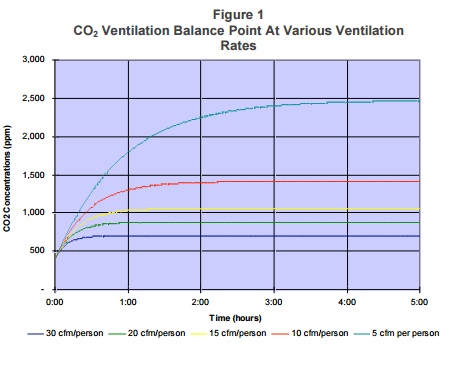by Dorothy Scholnick — December 2016
Air Quality and Productivity
Facility Managers (FMs) understand the importance of maintaining Indoor Air Quality (IAQ) compliance within a facility due to its direct relationship to occupant health and comfort. However, in addition to these benefits, a recently published study provides notable evidence that adequate IAQ can also have a positive effect on critical thinking and productivity in the workplace. The results specifically indicate that office environments with low levels of indoor pollutants and high levels of ventilation can significantly increase cognitive function in critical areas of decision making such as crisis response and strategy. In a culture that spends as much as 90% of the day indoors, this research becomes essential in understanding the relationship between indoor environmental quality and productivity.
The study conducted by Harvard T.H. Chan School of Public Health, SUNY Upstate Medical University and Syracuse University[1] included a blind test of cognitive function using a computer-based software tool designed to assess higher-order decision making skills. The blind study was conducted over the course of 6 days in an office environment to test the independent effects of volatile organic compounds (VOCs), CO2, and ventilation with outside air. The study compared participant performance while in “conventional” office environments (high VOC concentration and standard air ventilation) to “green+” office environments (low VOC concentration and double the standard rate of air ventilation). According to the results of the study, high VOC levels were judged to have a negative effect on cognitive performance, and increased outside air ventilation was judged to have a positive effect on cognitive performance. When tested in the green+ environments, participants averaged scores that were as much as double the scores that they produced under conventional environments. The research concludes that office environments with average VOC and ventilation rates are not providing the optimal environment to support cognitive function activities conducive to a productive working environment.
So what does this mean for Facility Managers? Some may initially consider from the results that if doubling outside air ventilation can greatly improve cognitive performance, then they should double air ventilation in their facility; or offices with average levels of total VOC (TVOC) should cut their total by 90% to reach the minimum tested in the study. But how would one do that? Implementing the changes that the research suggests requires not only a great deal of understanding of the systems involved in IAQ, but also the decision making tradeoffs that one needs to consider, including the economic and physical constraints. In an attempt to review the tradeoffs and considerations, the main variables of the research are discussed below.
VOC Level
VOCs are carbon based chemicals that can easily evaporate into the air at room temperature and pose adverse health effects for those who breathe them in. Common materials that can emit high levels of VOCs in office environments include building materials such as drywall, furniture, carpeting and paint, as well as office products such as toner, solvents, adhesives and cleaning supplies. The US Green Building Council’s LEED v4 Indoor Air Quality Assessment Credit sets a maximum amount of TVOCs at 500 μg/m3, a range that most office environments exceed. These guidelines are helpful for choosing materials for new construction, but have limitations in their application to existing buildings. The limitations arise from the inability to accurately measure current TVOC levels as well as determine which materials are responsible for emitting the most VOCs. Once a building is placed in service, active monitoring of VOCs is typically not performed since periodic and real time monitoring can be time consuming and cost-prohibitive.
A more cost-effective way to support a healthy environment with low VOC levels is to use a long-term strategy of developing a formal procurement policy for ordering office products and building materials that sets maximum limits for VOC concentrations. This procedure allows for positive change in IAQ and promotes improved cognitive performance over time. This type of procurement strategy can also improve an organization’s Corporate Social Responsibly (CSR) status, as it would aim to benefit both people and the environment. Table 1 provides additional resources that may be helpful in developing these procurement specifications.
Table 1
| Resource | Use |
| Environmental Protection Agency (EPA) website | Provides information on VOC sources |
| LEED v4 Indoor Air Quality Assessment Credit | Lists maximum concentration levels by contaminant |
| LEED v4 Low-Emitting Materials Third Party Certifications and Labels Credit | Lists certifications and programs for low emitting materials |
| Green Seal Certification Standards | Provides guidelines for low emitting products |
Table 1
Ventilation and CO2
Ventilation with outdoor air also plays an important role in the quality of indoor environments through air circulation and the dilution of indoor pollutants such as carbon dioxide. CO2 is considered an indoor pollutant because, if it is persistent in high concentrations, it can cause adverse health effects such as drowsiness and headaches. The primary source of CO2 is typically building occupants; the levels vary with the number of occupants and the activities they perform.
Figure 1 illustrates the diluting effects of outside air provided at varying rates, assuming CO2 levels of outside air are maintained at 400 ppm. Most spaces used for normal activity such as offices and classroom settings are designed to maintain an air ventilation rate of 15-20 cfm per person.
Figure 1[2]
Mechanical systems are designed to comply with the appropriate building code when they are designed for use and installed within a building; the quantity of outside air required is dependent upon building size, occupancy, and space use. Building codes draw from research performed by the American Society of Heating, Refrigerating, and Air Conditioning Engineers (ASHRAE) when defining minimum outside air requirements, and in some cases may directly reference ASHRAE Standard 62.1. For this study, ASHRAE Standard 62.1 was used to define the “standard” condition.
Since mechanical systems are designed to provide a specified ventilation rate, simply doubling the design outside airflow rate may exceed the system’s design capacity. It may become cost prohibitive to make renovations or replacements to existing mechanical systems to achieve air ventilation above the code requirements. Increased ventilation typically increases operating costs as the increase in outside air rate results in a commensurate increase in heating and cooling loads. The additional energy usage and operating cost must be weighed against anticipated improvements in indoor air quality. A life-cycle analysis of the options should be used to analyze whether increasing the ventilation rate would bring enough benefits to justify the added resources.
A good starting point to understanding the facility’s baseline air ventilation production is to be familiar with the appropriate building code standard on ventilation rates for each type of space, as well as the design capacity of HVAC equipment in place. The next step would be to measure the current levels of ventilation rates for any variance between what the system should produce and actual performance; this could be done through a variety of options with varying levels of difficulty, costliness, and expertise. Measurement and monitoring strategies include use of hand held devices, installing sensors, or installing air stations (see Table 2). The data analysis can be done on a quarterly, semi-annually or annual basis to monitor and maintain standard IAQ levels over time.
| Costliness | Method | Requirements |
| $ | Hand held device | Renting/purchasing the equipment and training on use |
| $$ | Sensors | Purchase of equipment, routine inspection, training and monitoring |
| $$$$ | Air station | Purchase of equipment, planned maintenance, training and monitoring |
Table 2
It is recommended that measurements are conducted throughout each floor for each type of space. For those that may not have the resources to conduct a full evaluation, it is important to look out for signs of potential issues with the air ventilation in a space, such as occupants complaining of a feeling of “stuffiness” or headaches. These types of symptoms may indicate a high volume of indoor pollutants. In addition to making the space feel uncomfortable, an area that is heavy with indoor pollutants can cause building-related illnesses such as sick building syndrome and allergies.
Conclusion
Even though it may not be economically feasible to increase air ventilation above code requirements, this research makes it clear that maintaining adequate levels of air ventilation is essential for promoting a healthy and productive working environment. If increasing ventilation can as much as double cognitive performance, it follows that there must be adverse effects on performance when ventilation rates are not meeting code. It is clear that levels of comfort and occupant health have a direct effect on an occupant’s ability to be productive; and for this reason it is important to be proactive about indoor air related issues and take occupant feedback seriously.
This research presents many opportunities for FMs to explore as possibilities to improve their organizations and make arguments for sustainable improvements. In order to maintain IAQ levels that support a healthy and productive working environment over time, it is best practice to implement an ongoing program that is updated as needs change. After evaluating the options, consider which methods would work best within the context of your facility in effort to provide a healthy indoor environment conducive to productivity.
References
[1] Allen, Joseph G., and Piers MacNaughton. Usha Satish, Suresh Santanam, Jose Vallarino, John D. Spengler. “Associations of Cognitive Function Scores with Carbon Dioxide, Ventilation, and Volatile Organic Compound Exposures in Office Workers…,” Environmental Health Perspectives 124, no. 6 (June 2016). doi:10.1289/ehp.1510037.
[2] “CO2 Ventilation Control and Measurement of Outside Air.” Air Test Technologies. Web. Accessed December 2016. http://www.airtesttechnologies.com/support/datasheet/CO2MeasurementAndOutsideAir.pdf.
 Dorothy Scholnick is a Staff Professional at Facility Engineering Associates. She has a background in facilities management and works under the facility consulting services line that specializes in facility asset management, building energy management, and sustainability services.
Dorothy Scholnick is a Staff Professional at Facility Engineering Associates. She has a background in facilities management and works under the facility consulting services line that specializes in facility asset management, building energy management, and sustainability services.
